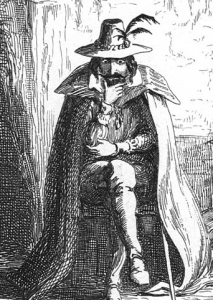Where do I get off calling my blog “left-trad,” anyway? Didn’t the Church condemn socialism? And so many leftists are hostile to religion—look at how Marx denounced it. Look at how many Christians were killed by communists! How can a confessing Catholic be a leftist?
I am so glad you asked, he said, having put the hypothetical question in the audience’s mouths. To answer that, we’re gonna have to define some stuff, so strap in.

The Left is a nickname dating to the late eighteenth century. As the French Revolution kicked off, the representatives of the Estates General [1] gathered into two main blocs: one, who more or less defended the monarchy and the Ancien Régime (including the social and political power of the Catholic Church), sat to the right of the parliamentary presider; the other, who opposed the aristocracy and favored equality, sat to his left. Ever since, “the right” has roughly meant people who think we should preserve (or reintroduce) political hierarchies and their attendant privileges, while “the left” has roughly meant people who advocate an egalitarian society. Obviously the development of both sides through history is a lot more complicated, but them’s the basics.
Defined as simplistically as this, I hope it’s easy to see why Catholics could be leftists. But the picture requires a lot more nuance. For example, this description only really covers class hierarchy, and it only covers that in terms of social status (nobles versus commoners). It doesn’t touch on economic class (rich versus poor versus middle class), a hierarchy which doesn’t map quite neatly to class-as-status. For example, the idea of nouveau riche versus “old money” is that old money is inherited, and thus associated with the leisured refinements of culture—which you don’t have time to acquire if you’re busting ass getting as rich as the gentry; so a person can change economic classes without being able to change social class, or not nearly as easily.
Exactly how to reform or abolish these class systems, which exist in different forms from country to country (e.g., we don’t officially have an aristocracy in the US, yet we have families like the Bushes and the Kennedys that play a partly similar role), is a contentious issue between different left-wing groups. [2] Depending on how they think societies work, some may focus mainly on economic issues, while others focus on legal power structures; some may favor confrontational, or even violent, tactics, while others believe in coalition-building and incremental reform.

This range of beliefs is partly why Catholics actually have had a small yet noteworthy presence in leftist circles over the years. A Catholic priest was one of the founders of the Industrial Workers of the World, hardly more than ten years after Pope Leo XIII declared that workers had the right to unionize. César Chávez and Ven. Dorothy Day were outspoken left-wing Catholics defending the rights of workers and of the poor in general; for that matter, Pope Benedict XVI said, less than a year after his election, “In many respects, democratic socialism was and is close to Catholic social doctrine”. [3]
All this leaves out two important things: the “New Left,” which was formed largely in the 50s and 60s, and liberalism—which is actually something quite different from the left. I’ll be talking about those in my next.
CST 102: Liberalism vs. the Left
CST 103: The Oppression Olympics
CST 104: More Like Catholic Socialist Teaching!
[1] This was the equivalent of the British Parliament, or of Congress in the US.
[2] In fact, it’s kind of darkly hilarious to hear conservative or centrist commentators talk about “the left” as if it were a cohesive political entity. Infighting among leftists is incessant. Put three leftists in a room for an hour, and they’ll come out with five incompatible ideologies and seven black eyes.
[3] Given its spiral into hysterical Trumpism, I am loth to give First Things traffic, but this article dates to 2006 and it is by the Holy Father Emeritus, so if you want to see it for yourself, go nuts.












